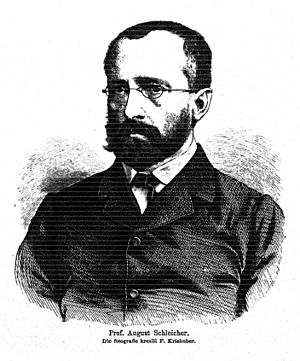August Schleicher facts for kids
Quick facts for kids
August Schleicher
|
|
|---|---|

August Schleicher, by Friedrich Kriehuber
|
|
| Born | 19 February 1821 Meiningen, Duchy of Saxe-Meiningen
|
| Died | 6 December 1868 (aged 47) |
| Alma mater | University of Tübingen, University of Bonn |
| School | Historicism |
|
Main interests
|
Indo-European studies |
|
Influences
|
|
|
Influenced
|
|
August Schleicher (19 February 1821 – 6 December 1868) was an important German linguist. A linguist is someone who studies human language. Schleicher is famous for his big book, A Compendium of the Comparative Grammar of the Indo-European Languages. In this book, he tried to figure out what the very first Indo-European language, called Proto-Indo-European, might have been like. To show how this ancient language might have sounded, he even wrote a short story, known as Schleicher's fable.
Contents
Life
August Schleicher was born in Meiningen, a town in what was then the Duchy of Saxe-Meiningen. This area is now part of Thuringia, Germany. He later passed away at the age of 47 in Jena, another city in Thuringia.
Career
Schleicher studied at the University of Tübingen and the University of Bonn. He later taught at the Charles University in Prague and the University of Jena. He started his studies learning about religion and Oriental languages, like Arabic, Hebrew, Sanskrit, and Persian.
Schleicher believed that a language is like a living organism. He thought languages grow, mature, and then decline over time. He wrote that languages start simple, then become more complex, and finally begin to simplify again.
In 1850, Schleicher wrote a book called The Languages of Europe in Systematic Perspective. In this book, he described languages using terms from biology, like genus, species, and variety. He also drew family trees to show how languages are related. He was one of the first linguists to use a tree shape to explain how languages developed.
Schleicher also wrote the first scientific book about the Lithuanian language in 1856/57. He thought Lithuanian was as perfect as ancient Greek and Latin languages.
He also believed in the idea of polygenesis for languages. This means he thought there were many original languages, not just one. He believed that many languages have disappeared over time, and new ones don't really appear anymore.
In 1866, August Leskien, another important linguist, began studying with August Schleicher at the University of Jena.
Linguistic Theories
Tree Model
Schleicher played a big part in developing theories about how languages change over time. He helped make the tree model popular in the study of languages. This model is like a family tree for languages. It shows how different languages grew from a single "parent" language.
Just like a family tree shows how people in a family are related, the language tree model shows how languages are connected. Languages that come from the same ancestor belong to the same language family. This idea is very important in comparative linguistics. This field tries to find and describe the ancient "proto-languages" that are the ancestors of today's language families.
However, languages don't always split perfectly like branches on a tree. Sometimes, languages borrow words or ideas from each other. This is like "horizontal transmission." Because of this, another idea called the wave model was created by Schleicher's student, Johannes Schmidt.
Comparative Model
The comparative method is a way to study how languages have changed. It involves comparing two or more languages that share a common ancestor. By looking at their similarities and differences, linguists can guess what that ancient ancestor language was like.
This method helps fill in missing parts of language history. It also helps us understand how sounds, words, and grammar systems developed. Important scholars like Rasmus Rask and Jacob Grimm helped develop this method.
Schleicher was the first linguist to actually write down reconstructed words from a proto-language. He did this in his book, Compendium der vergleichenden Grammatik der indogermanischen Sprachen, published in 1861.
Schleicher's Fable
Schleicher's fable is a short story written in a reconstructed version of the Proto-Indo-European (PIE) language. Schleicher wrote it in 1868. He was the first scholar to create a full text in PIE. The fable is called Avis akvāsas ka, which means "The Sheep and the Horses."
Over time, other scholars have made their own updated versions of Schleicher's fable. This is because our understanding of what PIE might have looked like has changed. The fable helps show how much our ideas about this ancient language have developed over the last 150 years.
Works
- Sprachvergleichende Untersuchungen. / Zur vergleichenden Sprachgeschichte. (1848)
- Linguistische Untersuchungen. Part 2: Die Sprachen Europas in systematischer Uebersicht. (1850)
- Handbuch der litauischen Sprache. (1st scientific compendium of Lithuanian language) (1856/57)
- Die Deutsche Sprache. (1860)
- Compendium der vergleichenden Grammatik der indogermanischen Sprachen. (1861/62)
- Die Darwinsche Theorie und die Sprachwissenschaft – offenes Sendschreiben an Herrn Dr. Ernst Haeckel. (1863)
- Darwinism Tested by the Science of Language. (Translated 1869)
See also
 In Spanish: August Schleicher para niños
In Spanish: August Schleicher para niños

